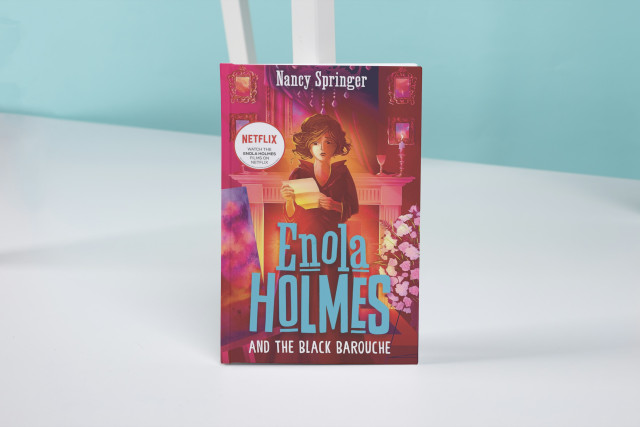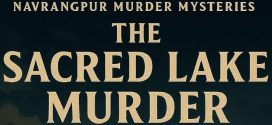Exploring the various adaptations of the world of Sherlock Holmes stories by Sir Arthur Conan Doyle, we came across the book series by author Nancy Springer who writes adventures featuring Sherlock‘s much younger sister Enola.
| Book Title | : | Enola Holmes and the Black Barouche Enola Holmes - 7 |
| Author | : | Nancy Springer |
| Published by | : | Allen & Unwin |
| # of Pages | : | 373; (Kindle EBook) |
| # of Chapters | : | 20 |
| Purchase Link(s) | : |
We have reviewed the first six books in this series here on Thinkerviews platforms.
- The Case of the Missing Marquess
- The Case of the Left-Handed Lady
- The Case of the Bizarre Bouquets
- The Case of the Peculiar Pink Fan
- The Case of the Cryptic Crinoline
- The Case of the Disappearing Duchess
Continuing Enola‘s adventures is the seventh book called Enola Holmes and the Black Barouche.
This Is Here In For You
Book Cover:
Let us take a look at the cover page of this book.

Enola Holmes and the Black Barouche | Book Cover
The cover page of this book marks a change in the theme of the book series published so far with a similar thematic background. This coverpage is more in line with currently popular colour and graphic themes, giving it a modern look. The cheerful background and a sticker announcing Netflix adaptation announces the success of the series and its central character with the readers.
The girl reading a letter in a room with historical era decorations shows one of the significant moments of the book and the readers will identify as they read through the book.
I have also linked another version of the cover page later in this review article which gives it a look of a movie poster.
Storyline:
This book starts with Sherlock Holmes telling the readers about how the past few adventures have seen him cross paths with his younger sister Enola and the evolution of their relationship.
As Sherlock falls into one of his melancholic moods at end of a case, Enola is visiting him with a view to cheer him up. It is during this visit, that they have an unexpected visitor – Letitia Glover – who goes by Tish. She has recently received a letter informing her that her twin sister Felicity died suddenly and her body has been cremated. Tish cannot believe the news and suspects that her brother-in-law Caddie (Cadogan Burr Rudcliff II, Earl of Dunhench) is hiding something. Considering that Caddie’s first wife also died in similar tragic circumstances, it stands to reason that something is not right about this news.
Enola accepts the case and starts investigating the Earl of Dunhench. And so she leaves the fog of London behind to visit the countryside of Surrey. A misadventure with a willful horse and lack of a chaperone results into Enola arriving to the hall of Dunhench, uninvited and rather disheveled. Surprisingly, in spite of her rather thin story, she is allowed to stay as a visitor. She is shown Felicity’s paintings and given her clothes to wear for dinner.
During the dinner, Caddie interrogates her and then locks her up in felicity’s room. Enola escapes by making a rope out of bedclothes and climbing out from the window. At the gates, she runs into Sherlock who has come looking for her, and together they return to London.
Through all this running about, they have discovered that Felicity was taken away in a Black Barouche. What does that mean?
As they decipher the clues, Enola ends up visiting the institution known as Bedlam, the family of the first wife of Caddie who disappeared in similar circumstances and draws in the gentlemanly person of Tewky (the Missing Marquess from her very first adventure).
Can the combined forces of Enola, Sherlock, Dr. Watson and Tish discover the missing lady?
Views and Reviews:
This book, in many ways, marks the transition of Enola from a teenage girl to someone approaching the world as a young woman. Enola has now found a residence with the professional women of London, she loves dressing up smartly, she has found common ground with her brothers and in that way has family with her. While collaborating with Sherlock, she still maintains her independence, her own way of working and sees herself primarily as the perditorian – a finder of lost things.
And so the case of the missing lady is appealing to her and while we have seen her working with missing persons and disappearance cases in previous books, this book brings in the added element of mental illnesses. The list of what counted for mental illness for women in the late nineteenth century was a wide range of behaviours. It was not very difficult to class a woman as mad and send her off to one of the multitudes of institutes, where they were kept in very poor condition and treatment could be borderline cruel.
We may look back upon those times and feel it to be a shock to our modern sensitivities, but mental illnesses are still not very well understood in many parts of the world and this book is a good reminder of how easy it would be to lose someone in places like these.

Enola Holmes and the Black Barouche | Book Cover
On the adventurous side, Enola ventures back into the countryside and the author describes the beauty of Surrey as seen through her eyes:
Surrey offered vistas of soft hills like billows on a sunny green ocean studded with cozy white boats – cottages, I mean, each with its flower garden and rose beds and milk cow, between which meandered peaceful waterways decked with lily pads. This was a verdant, comfortable corner of England where no dangers should lurk.
The author also shows us the Victorian era’s love for the extensive mourning by wrapping even door knockers and mirrors with black. Enola also continues to show us her sharp and realistic observations about people through lines like:
Although not exactly in disguise, Sherlock did manage to blend into the populace in brown trousers bagged at the knee from wear, a slightly frayed jacket, and an old hamburg. As for Watson, there was no need for him to modify his appearance in any way; he was, and always had been, deceptively undistinguished.
And Enola does use words that would really stretch your knowledge of vocabulary:
I knew myself to be tall, like my brother, and dolichocephalic, like my brother, and regrettably similar to him in profile, which is to say, proboscis.
Fungible. Interchangeable, one much the same as another, like cattle or clothespins or checkers on a board. Our mother taught me the word to describe a certain kind of womanizer.
There is a subtle commentary on the layers of society of the time in this book as well. The aristocracy and their off-putting behaviour towards rest of the populace, the general lack of facilities for single women travelling alone, and the comic as well as tragic events resulting from it. But as it is a mystery featuring well-known detectives, we also have one-liners like:
Finding nothing does not prove there is nothing to find.
Time is a peculiar phenomenon, pretending to be regulated by clocks and watches, yet speeding or lagging just as it chooses.
Summary:
An enjoyable segment in the series of adventures for Enola Holmes as she yet again goes on a journey to find someone missing….
ThinkerViews Rating:
Around 7.5 stars out of 10.
Quick Purchase Links:
- Buy - Enola Holmes and the Black Barouche by Nancy Springer - Paperback - Amazon IN
- Buy - Enola Holmes and the Black Barouche by Nancy Springer - Kindle EBook - Amazon IN
- Buy - Enola Holmes and the Black Barouche by Nancy Springer - Paperback - Amazon US
Over To You:
If you already have read the book do share your remarks and thoughts via comments below. Does this review help you in making your decision to buy or read the book? Do not forget to share this article with your friends over various social networks. Please follow/subscribe us on various Social networks like Twitter, Facebook, YouTube, Spotify, Amazon Prime Music, Audible, and others. And yes, you may like to subscribe to our RSS feeds to get latest updates for the site to land right in your mail box.
 ThinkerViews – Views And Reviews Personal views and reviews for books, magazines, tv serials, movies, websites, technical stuff and more.
ThinkerViews – Views And Reviews Personal views and reviews for books, magazines, tv serials, movies, websites, technical stuff and more.



